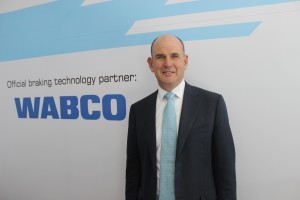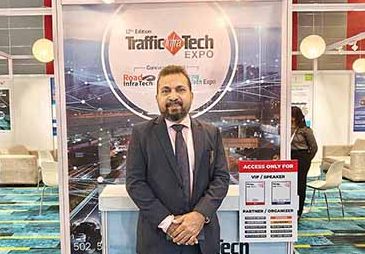Wabco is working with manufacturers in India to introduce advanced driver assistance systems and its latest air disc brakes. Its vision is to bring to India the most advanced technologies that it has been developing for Europe. “We work upon a more cost-effective version that could be rapidly offered in India and continue our drive to provide cost-effective, quality products and to bring in new technologies,” Jacques Esculier, Chairman and CEO, Wabco, told Anirudha Raheja. The excerpts:
Q: Automated Manual Transmissions (AMTs) seem to find growing acceptance in India. What is your outlook?
Esculier: We are working with all local OEMs to validate the tool set. There are more than a thousand AMTs running. These include the units fitted to the Ashok Leyland Janbus. It must be understood that AMT makes attractive value for any fleet. It allows even less experienced drivers to drive any truck or bus without the need to understand the optimal gear shifts in the interest of fuel efficiency and the wear and tear of mechanical systems. Both are linked to the overall maintenance cost.
AMT, apart from fuel saving, gives access to less experienced drivers at a lower cost. The two make a powerful value equation that justifies the adaption of AMT. An AMT also makes a flexible concept as it is mounted on a manual transmission. At the OE level, there is no need to have two special configurations. They would have one configuration of manual gearbox on top of which they can add the AMT system which makes it highly cost effective. With experienced drivers becoming more and more expensive, AMT allows junior drivers to find a place. There’s a broader choice to make. From our penetration in India, we can say that it is attractive for the drivers to drive a vehicle which is fitted with an AMT.
Q: Will the new CV types make use of AMT in India?
Esculier: AMT is getting recognised as far as city buses are concerned. This will be soon followed by inter-city buses. Manufacturers are evaluating AMT for trucks also. The need is to have an electronically- driven and controlled engine in order to be able to connect the AMT with it. A dialogue between the two is necessary. Majority of the engines are currently controlled mechanically. With the move to Euro IV, there will be a need to adapt electronically- driven and controlled engines. Once that happens, an entire spectrum of vehicles will open up for AMT application. AMT on trucks is right now under validation. It ensures smoother shifting of gears. In markets like Europe, AMT has penetrated almost 80% of trucks.
Q: ABS has been made mandatory in India. How does that augur for you?
Esculier: We are very proud of introducing ABS to the world of commercial vehicles in 1991. We have sold close to 17 million units globally. We are in complete support of the need of ABS in the country. I believe that by bringing new technologies to markets like India, they are made affordable. We see this going the same way it has been happening in Europe or in the US. Those technologies will be increasingly adapted by fleet owners. I think that there an enormous potential to enhance safety and efficiency of trucks on the road. This will also make local manufacturers competitive as they visit other parts of the world. Even when the global manufacturers brought new standards and new platforms with them, the local manufacturers have been quick to adapt. Not giving much space to others, local manufacturers have significantly enhanced their standards in terms of technology. They have been aggressive in telling us to bring new technologies that can enhance their platform.
Q: What does Wabco do for light-weighting?
Esculier: There are a lot of companies that are starting to think about using aluminium instead of iron for compressors. The industry has never been able to develop a purely aluminium cylinder without putting a liner in it. We have been able to do that. It is a breakthrough technology that does away with the liner and reduces weight. Light-weighting enhances payload capacity. It is cost- effective and one has to use selected materials from the design stage itself. We have focused a lot on that and India is the centre of excellence for that. Air disc brake, for example, is a very heavy product. It raises the weight of a truck by 50 to 100 kgs. We are working to reduce the weight of the air disc brake system. There is no product at Wabco that is designed anywhere in the world without the involvement of Indian engineers.
Q: What are the new technologies that you have for India?
Esculier: Our ambition and vision is to bring at the earliest to India the most advanced technologies that we have been developing for Europe. Earlier it used to take years as they were often too expensive. We have altered our approach. We now release new technologies at times even before we release them elsewhere. We work upon a more cost- effective version that could be rapidly offered in India.
We are working with manufacturers here to introduce advanced driver assistance systems such as collision mitigation systems and lane departure warnings. We are also talking about our latest air disc brakes, which is the lightest and probably the most cost- effective air disc brakes in the world. They have already been accepted by Daimler for 50% of the Actros range. The supplies for them have started in Europe. We want to continue our drive in India to provide cost- effective, quality products and to bring new technologies.
Q: How soon will the demand for air disc brakes technology gain momentum in India?
Esculier: It depends on the demand we get for air disc brakes in India. We can think of localising the product. It needs investments which will be justified by volumes. I think the demand for air disc brakes in CVs will grow in India as the value proposition is very compelling. The gap between drum brakes and air disc brakes is rapidly closing. We have been optimising the design of our air disc brakes to make them less expensive to manufacture. The maintenance cost is less expensive than changing pads. It takes less time to replace. Europe has moved to air disc brakes. We are also working with countries like the US to help them migrate to air disc brakes. One has to recognise that air disc brakes enhance safety as they reduce the braking distance.
Q: Would the application of air brakes technology pose a challenge in India?
Esculier: The design that we have developed for Europe and the US can be applied in India. It would not require much adaptation except certain wheel amplification configuration. What is interesting in my view is globalisation. European truck manufacturers are making trucks in India, and local manufacturers are expanding their base globally. This is shortening the time taken to adapt new technologies.
Technologies on trucks will harmonise like in cars the world over. Now there is a big gap. When you look at the systems and products that Wabco delivers in Europe, it amounts to about USD 3,200 per truck, which is less than one-sixth in India. There is a big gap to close. In my view, the gap will narrow in the coming years. It would provide enormous amount of activities and opportunities for companies like Wabco.
Q: For a cost sensitive market like India, would driver assistance technologies be out of reach for many?
Esculier: We first came up with an extremely reduced cost opportunity. We started it after introducing the concept in Europe and the US. In the US, it is proven that collision mitigation systems are extremely efficient in cutting down the rate of accidents. The biggest source of accidents that involves commercial vehicles on the road is the back- end collision particularly in the morning when the driver may not be fully alert. Such systems reduce a chance of collision by up to 87%. This makes the initial price of the system justifiable. We have sold more than 150,000 units of these in the US. It is not mandatory, but if the trucking industry in the US is buying even though it is not thought to be necessary, it is financially justifiable.
Q: So, what assistance technologies do you offer for India?
Esculier: We are basing our Advance Driver Assistance Systems (ADAS) on ABS. We are also offering EBS, but the majority of the market will rely on ABS for now. All the technologies related to driver assistance system can be connected to ABS without the need to have EBS. What we are doing is to allow a truck to apply partial brakes in case of an obstacle on the road. We are also providing engineering lane departure warning systems apart from side sensors that would actually detect people around the truck, especially when the truck is taking a turn. The inability to detect people around when taking a turn is a major source of fatalities in Europe involving commercial vehicles. We have invented a fairly elegant technology around LIDAR that will allow detection of such obstacles. We have multiple technologies and functionalities around trailers. We developed them for Europe, and are now taking them to the rest of the world. There are 45 different activities which we call as intelligent trailer package. They will be made available as the market for trailers grows in India.
Q: How is the Indian market adapting to next generation products?
Esculier: There is a certain pace with which the market will adapt new technologies. These technologies will be available at an affordable cost and will make trucks more reliable. EBD is an electronic version of ABS. Both basically perform the same function. EBS involves electronic signals over ABS’ mechanical stuff. Both keep the wheels from locking prematurely. Europe has already imposed stability control. The US will soon impose it. Stability control differentiates pressure on brakes across different wheels so that pressure can be modulated for not hampering stability involving tractors, trailers and both. Rollovers can be avoided. This, next level of safety is what I think will come to India.
Q: Will you have to wait for inclusion of such technologies until made mandatory?
Esculier: Every country is like this. Fleet owners would push to reduce the price every time a CV manufacturer would want to increase it except when it is mandated, or when they see a clear value addition in terms of fuel saving or reduction in insurance premium. It is happening in the US. Premiums are going down as the rate of accidents is reducing. People are clever and would do what is in their best interests. ACI









Leave a Reply